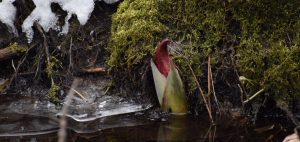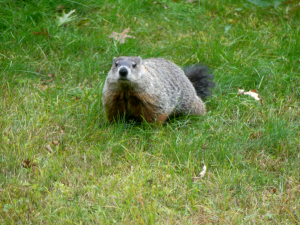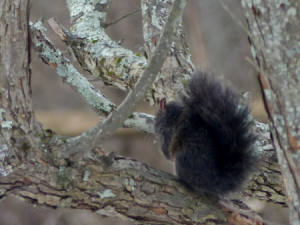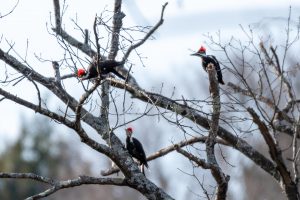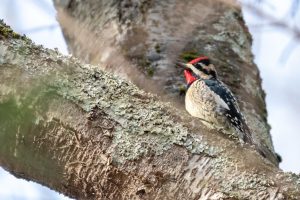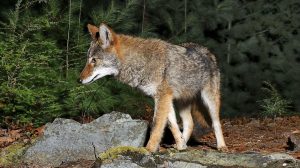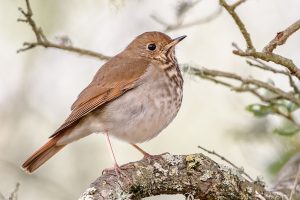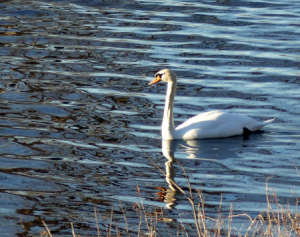Written by Gwyn Loud for the Lincoln Land Conservation Trust. She welcomes your sightings and questions at 781-259-8690 or gwynloud555 at gmail.com.
Ms. G the official Massachusetts groundhog, did not see her shadow at Drumlin Farm on Ground Hog Day, Feb. 2, meaning that spring will come early if we believe the folklore. In fact, the spring equinox is only a month away on March 19. Many ponds still have a skim of ice, as the temperature has dropped below freezing at night for weeks. It feels as if we have had numerous gray rainy days, good for the water table if not our spirits. As of this writing, we have only had tiny amounts of snow over the past month, giving us a primarily brown and gray landscape, punctuated by the green of evergreens and resting lawns. The plants are all waiting, however, with buds ready to burst with the warmth of the coming season. My forced forsythia clippings provide a welcome indoor harbinger of spring, and a friend reported that her daffodils are poking up through the leaf litter. It will soon be sugaring season, so watch for the buckets hung on maples.
Skunk cabbage, unrelated to cabbage, is emerging in streams and swampy places. This unusual plant can actually generate heat through a process called thermogenesis. The plant increases its respiration in early spring, the knob-shaped flower cluster absorbing oxygen and rapidly burning starch in its large underground root system. A purple pointed “monk’s hood” protects the flower, creating a little warm environment of a steady 72º. Honeybees, searching for flowers in early spring are attracted to the protein-rich pollen.
Coyotes have been seen and heard all over town, not surprising as it is their breeding season and a time when they howl more often. The females come into heat just for five to ten days and during this time both males and females often leave scent markings of urine or feces. Mary Holland, expert naturalist from Vermont, writes in her blog, “One unusual aspect of the coyote breeding season is the coyote’s ability to change its breeding habits according to its population status. When their population is threatened and/or pressured, coyote litter sizes go up. They use their howls and yipping to assess coyote populations — if their howls are not answered by other packs, it triggers a response that produces large litters. The normal size of a coyote litter is five to six pups. When their populations are suppressed, their litters get up as high as 12 to 16 pups. Research shows that the number of coyotes in a given area can be reduced by 70 percent but the next summer their population will be back to the original number.” Other local mammals which breed in February include raccoons, foxes, gray squirrels, and beavers. Beavers, which form permanent breeding pairs, breed in the water; mating has to be quick as the female is only in heat for 12 to 24 hours.
Observers have seen mice dashing across the road, and I watched a white-footed or North American deer mouse (too similar to tell apart unless you examine enzymes in their saliva!) happily eating birdseed under my feeder during the day. A hole in the lawn nearby probably leads to its underground nest, where it keeps warm with other mice. A resident near Farrar Pond sent a photo of a black squirrel; this is not a separate species but is a gray squirrel with mutated genes affecting the fur’s pigmentation.
Chipmunks have just started emerging from their winter burrows and I was excited to see a beautiful jet-black fisher cross Conant Road recently. An observer on Old Sudbury Rd. noticed a raccoon out in broad daylight and wrote, “It was staggering badly, and often rolling over motionless. I thought rabies or some other illness and considered inviting the police to put it out of its misery and our menace. But after extended observation, I decided that it was just drunk. I’ve seen mammals of all kinds, and even birds, acting a bit loopy, presumably from too many frozen-thawed-fermented crabapples, native persimmons or other fruit. But this was an extreme case.”
Many of our winter birds are now beginning to sing spring songs. We may hear the drumming of woodpeckers, the descending “peer peer” of cardinals, or the twittering of house finches. Lots of bluebirds are exploring nest boxes. At Drumlin Farm two male wild turkeys were seen fighting, open-mouthed and locked together in what must have been a dominance struggle. Soon tom turkeys may be spotted strutting and fanning their tails in courtship displays. A single grackle was at feeders in two places, and I had three male red-winged blackbirds at mine. Are these early spring arrivals or hardy winter visitors? We can expect to hear red-winged blackbirds calling near streams and swamps about February 20, a sure sign of the approaching season. The first large flock of common grackles descended on my feeding area on Feb. 16.
Other recent bird sightings of note include common ravens in a couple of places, northern flickers, yellow-bellied sapsuckers, mute swans on the Sudbury River, and several pileated woodpeckers, including three together (see photo) near the Flints’ Farm. A Winter St. resident had not just one but three male Eastern towhees eating birdseed on the ground, and a number of over-wintering hermit thrushes have been reported. Several observers have seen barred owls, which are in mating season. I witnessed a Cooper’s hawk land on the lawn near the bird feeders, then walk across the lawn and around the corner of the house to peer hopefully inside a bush. It was so odd to see it walking! As I write I have just seen perhaps the same hawk capture a female red-bellied wood pecker and start to eat it; hard to watch but everyone has to eat.
Looking skyward, enjoy Venus, the bright evening “star” in the west. Counterintuitively, Earth was closest to the sun (perihelion) for the year back on January 5, which was 3,109, 476 miles closer than we will be on July 4, thanks to our elliptical orbit. And keep an eye on Betelgeuse, the red supergiant bright star in the left shoulder in the constellation Orion. Since the fall it has been dimming, which has astronomers wondering what is happening. For more on what this might mean check out https://www.nytimes.com/interactive/2020/01/09/science/betelgeuse-supernova-fading.html.
© Gwyn Loud


